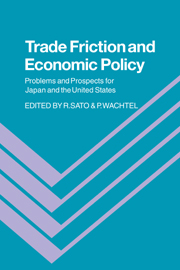Book contents
- Frontmatter
- Contents
- Foreword by Richard R. West
- Preface
- List of contributors
- 1 Introduction
- Part I Sources of trade friction
- Part II Macroeconomic policy
- Part III Trade policy
- 10 Costs and benefits to the United States of the 1985 steel import quota program
- 11 Limits of trade policy toward high technology industries: the case of semiconductors
- Index
10 - Costs and benefits to the United States of the 1985 steel import quota program
Published online by Cambridge University Press: 05 February 2012
- Frontmatter
- Contents
- Foreword by Richard R. West
- Preface
- List of contributors
- 1 Introduction
- Part I Sources of trade friction
- Part II Macroeconomic policy
- Part III Trade policy
- 10 Costs and benefits to the United States of the 1985 steel import quota program
- 11 Limits of trade policy toward high technology industries: the case of semiconductors
- Index
Summary
Introduction
U.S. trade policy on steel
During the past 15 years the United States steel industry has enjoyed a significant amount of special protection from imports. From 1969 to 1974 Japan and the European Economic Community negotiated “voluntary restraints agreements” (VRAs) that limited their exports to the United States. In 1978 the administration initiated the “trigger price mechanism” (TPM) as part of its program for the steel industry. The TPM was, in principle, to have established a minimum price below which imports could not enter without being subjected to an expedited antidumping investigation. In 1982 a major effort was undertaken by the majority of the integrated U.S. steel producers to obtain tariff protection under the antidumping and countervailing duty laws. Despite the fact that the Department of Commerce (DOC) made either a negative determination of subsidies or a “de minimus” or insignificant determination of subsidies for a significant portion of the European Economic Community (possibly eliminating the ability of countervailing duties to restrain imports due to additional supply from unrestrained suppliers), the European Community (EC) agreed to quotas on steel exports of specific products under the U.S.–EEC arrangement.
In early 1984, the United Steelworkers of America and Bethlehem Steel Corporation petitioned the U.S. International Trade Commission (USITC or ITC) for relief from imports under Section 201 of the Trade Act of 1974. In that “petition” they asked for quotas on imports of carbon and alloy steel products such that imports would be at most 15 percent of domestic apparent consumption.
- Type
- Chapter
- Information
- Trade Friction and Economic PolicyProblems and Prospects for Japan and the United States, pp. 159 - 183Publisher: Cambridge University PressPrint publication year: 1987



